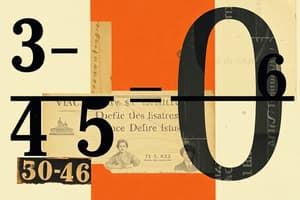Podcast
Questions and Answers
What does the digit '7' represent in the decimal 45.678?
What does the digit '7' represent in the decimal 45.678?
- 7 hundredths
- 7 ones
- 7 thousandths (correct)
- 7 tenths
How is the place value affected when moving from left to right across the decimal point?
How is the place value affected when moving from left to right across the decimal point?
- It is multiplied by 2
- It remains constant
- It decreases by a factor of 10 (correct)
- It increases by a factor of 10
In the decimal number 0.0093, which digit represents the hundredths place?
In the decimal number 0.0093, which digit represents the hundredths place?
- N/A
- 9
- 0
- 3 (correct)
What is the total number of decimal places in the product of 2.5 and 1.2?
What is the total number of decimal places in the product of 2.5 and 1.2?
What would be the new value of 0.04 if it were multiplied by 100?
What would be the new value of 0.04 if it were multiplied by 100?
In the decimal number 0.768, which digit contributes to the tenths place value?
In the decimal number 0.768, which digit contributes to the tenths place value?
If a decimal number has three decimal places, what does that indicate about the placement of the decimal point in relation to whole numbers?
If a decimal number has three decimal places, what does that indicate about the placement of the decimal point in relation to whole numbers?
For the decimal 2.045, which digit represents the thousands place?
For the decimal 2.045, which digit represents the thousands place?
Flashcards
Multiplying Decimals
Multiplying Decimals
Multiplying decimals follows the same rules as whole numbers, but you need to consider the decimal points in the answer.
Decimal Place Value
Decimal Place Value
Each digit in a decimal has a value based on its position relative to the decimal point, representing fractional parts of a whole number.
Decimal Multiplication Example
Decimal Multiplication Example
Multiplying decimals like 2.5 x 1.2, first multiply the numbers like whole numbers, and then place the decimal in the answer based on how many decimal places are in the factors.
Multiplying by Powers of 10
Multiplying by Powers of 10
Signup and view all the flashcards
Decimal Place Value Chart
Decimal Place Value Chart
Signup and view all the flashcards
Product
Product
Signup and view all the flashcards
Factors
Factors
Signup and view all the flashcards
Estimation in Decimal Multiplication
Estimation in Decimal Multiplication
Signup and view all the flashcards
Study Notes
Multiplying Decimals
- Multiplication of decimals follows the same basic principles as multiplying whole numbers, but you need to account for the decimal points.
- To multiply decimals, first multiply the numbers as if they were whole numbers.
- Then, count the total number of decimal places in both the factors (the numbers being multiplied).
- Place the decimal point in the product (the result) so that it has the same number of decimal places.
Decimal Place Value
- Decimals represent fractional parts of a whole number.
- The value of each digit in a decimal depends on its position relative to the decimal point.
- Digits to the left of the decimal point represent whole numbers, while digits to the right represent fractional parts.
- The place value of each digit increases or decreases by a factor of 10 as you move from left to right or right to left from the decimal point.
- Each place value to the right of the decimal point represents a tenth, hundredth, thousandth, ten-thousandth, and so on.
- For example, in the decimal 3.14:
- The '3' represents 3 ones.
- The '1' represents 1 tenth.
- The '4' represents 4 hundredths.
Example
- Example: Multiply 2.5 x 1.2
- Multiply the numbers as if they were whole numbers: 25 x 12 = 300
- Count the decimal places in both factors: 2.5 has one decimal place, and 1.2 has one decimal place.
- The total number of decimal places is 1 + 1 = 2
- Place the decimal point in the product so that it has two decimal places: 3.00
- Thus: 2.5 x 1.2 = 3.00
- Alternatively, the result can be written as 3. (the trailing zeros are unnecessary in the decimal)
Strategies for Multiplying Decimals
- Estimating the product before multiplying can help in determining the reasonableness of the calculated solution.
- Multiplying decimals can be simplified by moving the decimal point; this often happens with powers of ten, resulting in a shift of the digits.
- Rounding the decimal factor(s) allows for a more straightforward calculation.
Multiplying by Powers of Ten
- When multiplying a decimal by a power of ten (10, 100, 1000, and so on), move the decimal point to the right by the number of zeros in the power of ten.
- Example: 0.56 × 10 = 5.6 (move the decimal point one place to the right)
- Example: 1.234 × 100 = 123.4 (move the decimal point two places to the right)
- Example: 0.678 × 1000 = 678 (move the decimal point three places to the right)
Studying That Suits You
Use AI to generate personalized quizzes and flashcards to suit your learning preferences.




